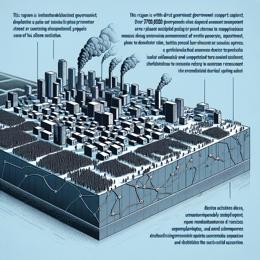Image created by AI
The Looming Hunger Crisis: Zimbabwe's Battle with Food Insecurity
A confluence of adversities, spanning from relentless climate change impacts to grave economic malaise has plunged Zimbabwe into a state of food insecurity, escalating to levels akin to territories beset by conflict. This striking assertion comes from a senior official at the World Food Programme (WFP), spotlighting Zimbabwe’s status among the globe's most acute hunger emergencies.
Francesca Erdelmann, the WFP's country representative in Zimbabwe, delineated the dire straits the nation finds itself in during a recent interview, citing a blend of "economic dynamics, currency issues, and climatic problems," among other factors contributing to the perpetual appearance of Zimbabwe on global food-security risk reports.
Placed in distressing company with regions like Ukraine, Gaza, and several countries across Africa's Sahel belt, all confronting their distinct yet comparably grim food scarcity trials, Zimbabwe’s situation is further exacerbated by its protracted political and fiscal disruptions. These disruptions have severely incapacitated the country's grain production capabilities and hamstrung its capacity to procure funds on international platforms essential for amassing requisite food reserves in the wake of inadequate harvests.
Compounding these woes is the trajectory of the Zimbabwean currency. Overwhelmingly rejected by the populace, the Zimbabwe dollar has undergone a precipitous devaluation, losing nearly half of its value compared to the US dollar since the beginning of the current year, rendering it the world’s second most depreciated currency after Lebanon’s pound.
As per Erdelmann's overview, approximately 2.7 million rural Zimbabweans are projected to experience significant grain shortages during the year's first quarter. Climate-related challenges, such as the El Niño syndrome, capricious rainfall, and surging temperatures, threaten to undermine this agricultural season’s yield, potentially leaving a multitude of people grain-deficient before the forthcoming harvest. These adversities combine with the annual requirement of approximately 2 million tons of grain to maintain a balance, a benchmark increasingly difficult to meet amid current predicaments.
The gravity of the situation underscores the multifold nature of the threats confronting Zimbabwe’s population and the urgency of addressing them. To mitigate the impending crisis, a concerted effort by international aid agencies, alongside the implementation of sustainable policies aimed at climate resilience and economic stability by the Zimbabwean government, are ever more critical.
In prioritizing assistance, focus must also be cast on immediate nutritional aid, support for local agricultural initiatives to boost self-sufficiency, and strategies to stabilize and eventually revive Zimbabwe's ailing currency. The survival and well-being of millions rest on the agility and adequacy of these responsive measures as the country grapples with the harrowing prospect of a hunger catastrophe, one that mirrors the worst fear of nations embroiled in war yet bred in a landscape of peaceful desperation.



